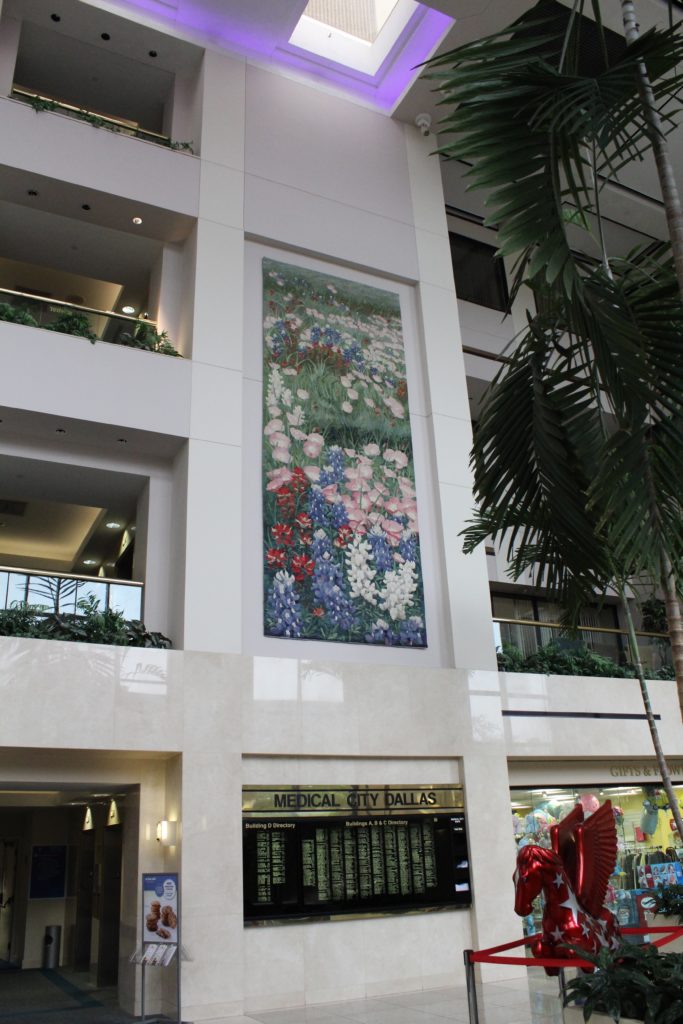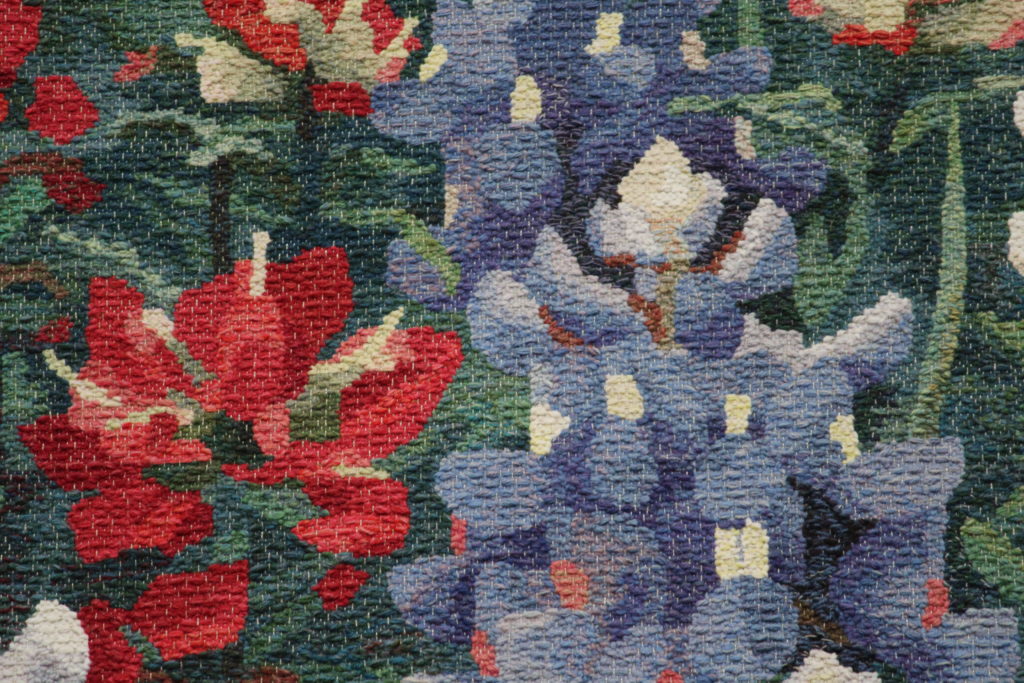Inspired by some of Joanne Hall’s exquisite large tapestries, I have been taking steps to learn her techniques. This fascinating style that is unique to Joanne enables her to weave large tapestries at a comfortable pace. My Lizard tapestry last year was a step in this direction. (See Quiet Friday: Lizard Tapestry.) One thing that the lizard taught me is how much more I need to learn. So, you can imagine my delight in having the opportunity to take a Pictorial Tapestry Weaving workshop taught by Joanne Hall last week! (Contemporary Handweavers of Texas Conference in Fort Worth was the setting.)


Things to remember: Don’t beat hard. Bubble the weft more. Color theory is invaluable for adding depth and intensity. Simplify the cartoon. And countless more bits of insight and instruction! I am invigorated in my pursuit to develop these tapestry skills. Expect to see a tapestry on my 120cm Glimåkra Standard in coming days.










I find myself pondering how experiences fall into place in our lives. There are times when the stepping stones seem to be set out before us, showing the way, when we don’t know exactly where we are going. The Lord knows where I am going. He knows me. And he kindly sets out the next steps. Perhaps he smiles as he sees our delight when we figure out that we are the bundles of yarn in his tapestry.
May your joy in learning never cease.
Happy Weaving,
Karen

Thank you for sharing this. It is so interesting.
Hi Petrina, I’m glad you find it interesting. There’s so much to discover!
All the best,
Karen
Beautiful! Looking forward to seeing your progress. I don’t have the patience for tapestry.
Hi Beth, You might be surprised. In some ways it is similar to the inlay I’ve seen you do, but on a larger scale.
In any case, I’m pleased that there are so many directions we can go with yarn and threads and a loom.
Happy weaving,
Karen
Wow! Karen, you are always doing something amazing! Thank you for sharing the workshop since I was unable to attend any this year.
I am curious as to how you were able to bring your loom. It doesn’t look very portable.
Hi Annie, The whole conference was a great experience. Maybe you will be able to attend next time, 2021 in San Antonio.
These Swedish looms are easy to take apart and put back together. Think of it as large Lincoln Logs. The side gables are the biggest pieces. The rest —beams, crossbars, treadles, lamms— all fit into two large duffel bags. The gables and the duffel bags fit in the back seat of our Toyota Tacoma.
Karen
Oh my darling Karen! It is wonderful, reading your blog, this morning. En route to the Navajo Nation, our vehicle died in Albuquerque. What a story I have to share…His goodness to us…to place His people in our path…each one learning of us and needing prayer for themselves and their families. What a miraculous day He had planned.
Thank you for being YOU! Thank you for taking such grand pictures from our workshop with Joanne. It passed by us all too quickly.
Hi Charlotte, I love the accounts of God’s faithfulness.
Glad we got to share some learning time together.
All the best,
Karen
So fun to re-live the class through your pictures! Love your lily, that came out very well. I still haven’t put the Julia back together, I want to give it new dowels, so a trip to Lowe’s is on the list.
Hi Betsy, I’m so glad my CM loom had a sister in the room! It was fun to get to weave side-by-side with you.
Happy weaving,
Karen
It is so uplifting to learn from your heroes. It is a well of kindness that keeps on giving. Thank you for sharing. I appreciate the breakdown of technique and you were able to make tapestry seem just a little more approachable.
Hi Vivian, “Hero” is a good word to describe Joanne. We are fortunate that she is so willing to share her expertise.
If tapestry weaving seems more approachable, then I’ve accomplished one of my goals. Thanks!
Happy weaving,
Karen
Hi Karen, thanks for another great post. Joanne’s wildflower tapestry is a marvel. I’m wondering where she managed to find so many colors in what appears to be the same weight of yarn. Was it perhaps woven in the era of the famous Paternayan yarns (gone now and sadly missed)?
Hi Joanna, That’s a great question about the yarn. If Joanne sees this maybe she will leave a comment.
In the workshop we used mostly 6/2 Tuna wool and 6/1 Fårö wool. We made butterflies with the equivalent of 4 strands of Tuna wool. Using several strands together introduces great ability for variety of color and shading.
I agree that Joanne’s tapestries are marvels.
Happy weaving,
Karen
Back in the day I did a lot of needlepoint using Paternayan Persian wool yarn. The yarn came as 3 strands of 2-ply yarn and that put-up, combined with an incredible color range, enabled the stitcher to create the exact shade needed. It spoiled me. Do you know the date of JH’s wildflower tapestry?
Joanna, I’m sure your needlepoint images were spectacular!
Joanne Hall’s Texas Wildflowers tapestry was installed the summer of 1995.
Karen
Hi Joanna,
As Karen said, we used 2 ply Swedish wools, Tuna, 109 colors available from Glimakra. We can extend the color choices by also using the Faro yarn,an additional 74 colors, using two strands as one. I did some dyeing for the Texas Wildflowers tapestry, as it is hard to get clear pastel colors.
Joanne
Amazing. Beautiful.
Right place. Right time. The rose path warp on my loom is exceeding my filler on some rag rugs. This technique has inspired me to weave the last rug as a tapestry in a simple design from stringers of red currants.
Always an inspiration. Always a blessing.
Thank you.
Nannette
Hi Nannette, I would love to do some tapestry rag rugs at some point. I was thinking about that earlier this morning. Good for you!
All the best,
Karen
What a treat to open your blog for the first time since I signed up and see my little pear! I had so much to learn and Joanne stuffed as much as she could into my sponge of a brain. Not sure where it will lead, but such an intriguing path!
Hi Cindy, Your pear deserved to be seen! It’s good to go as sponges. It will be interesting to see where all this leads!
All the best,
Karen